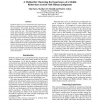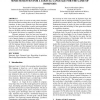160 search results - page 24 / 32 » Applying the Mu-Calculus in Planning and Reasoning about Act... |
AAAI
2000
13 years 10 months ago
2000
If robotic agents are to act autonomously they must have the ability to construct and reason about models of their physical environment. For example, planning to achieve goals req...
AAAI
1997
13 years 10 months ago
1997
We address the problem of visually detecting causal events and tting them together into a coherent story of the action witnessed by the camera. We show that this can be done by re...
RAS
2008
13 years 8 months ago
2008
In this paper we present the robot programming and planning language Readylog, a Golog dialect which was developed to support the decision making of robots acting in dynamic real-...
AIA
2006
13 years 10 months ago
2006
Epistemic logic allows to reason not only about situations, but also about the knowledge that a set of agents have about situations. In later years, epistemic logic has been appli...
PPDP
2010
Springer
13 years 6 months ago
2010
Springer
Transaction Logic is a logic for representing declarative and procedural knowledge in logic programming, databases, and AI. It has been successful in areas as diverse as workflows...


